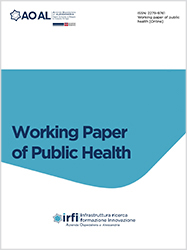Valutazione dell’appropriatezza delle misure di controllo relative alla trasmissione nosocomiale di microrganismi multiresistenti all’interno della SS Terapia Intensiva Polivalente: studio osservazionale
All claims expressed in this article are solely those of the authors and do not necessarily represent those of their affiliated organizations, or those of the publisher, the editors and the reviewers. Any product that may be evaluated in this article or claim that may be made by its manufacturer is not guaranteed or endorsed by the publisher.
Autori
Background: le infezioni associate all’assistenza sanitaria, per definizione, si verificano 48 ore o più dopo il ricovero, o entro 30 giorni dalla dimissione o da una procedura chirurgica; rappresentano una sfida significativa per il sistema sanitario a causa della loro prevalenza in Italia e del coinvolgimento della resistenza multi-farmaco. Le unità di terapia intensiva presentano la più alta prevalenza di tali infezioni a causa della scarsa aderenza ai protocolli di sicurezza. La causa principale delle infezioni acquisite in ospedale è la scarsa aderenza alle linee guida per la prevenzione e il controllo di queste infezioni. Questo studio si propone di valutare le misure di controllo delle infezioni in un’unità di terapia intensiva mista. Materiali e Metodi: è stato condotto uno studio osservazionale trasversale in un unico centro presso l’Unità di Terapia Intensiva Mista dell’Azienda Ospedaliera Universitaria di Alessandria. Lo studio ha utilizzato uno strumento di valutazione basato sul DVA 91 rev 03 emesso il 22.07.2012. Questo strumento fornisce indicazioni sul tipo di isolamento (per via aerea, per contatto, per goccioline), sulla sistemazione dei pazienti, sulle misure di assistenza, sui protocolli di pulizia e disinfezione, sul trasporto dei pazienti e sulla gestione dei visitatori. Risultati: complessivamente, sono state incluse 220 osservazioni, che hanno coinvolto principalmente infermieri (75,4%), maggiormente femmine (65,9%) e con un’età media di 35,8 anni e un’anzianità di servizio mediana di 36 mesi nell’Unità di Terapia Intensiva Mista. In particolare, tutte le osservazioni sono state effettuate su pazienti in isolamento da contatto. In 199 osservazioni (92,6%), gli operatori sanitari hanno eseguito l’igiene delle mani subito dopo la rimozione dei guanti. Conclusioni: i risultati evidenziano una forte adesione ai protocolli di controllo delle infezioni presso l’Azienda Ospedaliero- Universitaria di Alessandria. Questi sforzi promuovono una cultura della sicurezza tra gli operatori sanitari, garantendo l’efficace attuazione delle misure preventive.
Come citare

Questo volume è pubblicato con la licenza Creative Commons Attribuzione - Non commerciale 4.0 Internazionale.






